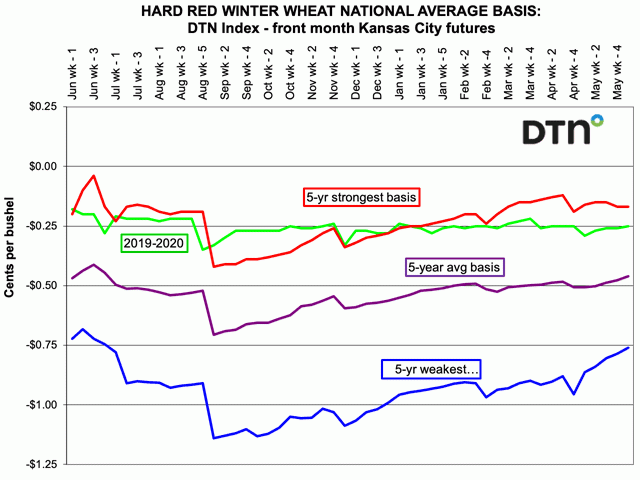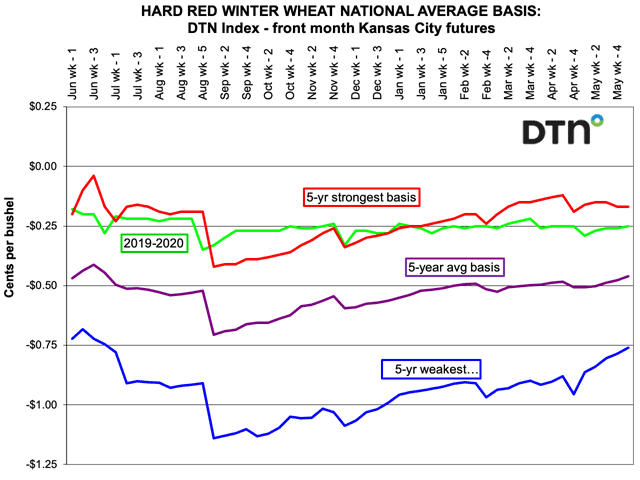Market Matters Blog
Out With the Old, in With the New: A New Crop Year Begins for Winter Wheat
In their annual U.S. Wheat (USW) Crop Quality Report, it was noted that the 2019 hard red winter (HRW) wheat crop received abundant moisture during the planting and growing season throughout the Great Plains, while swings in temperature and severe weather occurred in the Pacific Northwest (PNW) and Montana. "Unexpectedly high yields resulted in lower wheat and flour protein, but the crop exhibits good milling and end-product characteristics. Even though mixing times and tolerances are shorter than the 5-year averages, the loaf volumes achieved indicate there is adequate protein quality to make quality bread," said USW.
"Various climatic conditions challenged this crop," said USW. "However, moisture remained adequate, or even excessive in the central and southern production areas and resulted in better than expected yields, lower than average protein, but otherwise good milling and processing characteristics. The U.S. Southern, central and Northern Plains experienced an unusually wet spring, slowing crop maturity and uniformly delaying the beginning of the 2019 harvest by two weeks or more." Overall, the 2019 crop was sound, grading at 60.8 pounds and 11.8% protein versus 2018 protein of 12.3%
In their Sept. 30, 2019, Small Grains Summary, USDA estimated 2019 winter wheat harvested area at a record low 24.327 million acres, down 415,000 acres from 24.742 million acres in 2018. The average winter wheat yield was estimated at 53.6 bushels per acre (bpa) compared with 47.9 bpa in 2018. HRW wheat production was estimated at 833.181 million bushels (mb), 26% higher than 2018. Despite the lower planted acres, the 2019 crop was the third largest crop in the last 20 years, according to USW.
WHAT'S AHEAD FOR THE NEW CROP YEAR?
P[L1] D[0x0] M[300x250] OOP[F] ADUNIT[] T[]
The first week of the new crop year saw the DTN national average basis still running above the five-year average. While it is still early in the crop year to predict, that pattern may continue. Given the current drought and late April freeze damage in parts of Kansas and Oklahoma, and some disease pressure, it is possible new-crop wheat may face some quality issues.
The KC spot market old-crop basis has been strong for the lower proteins, but recently basis weakened, likely due to harvest pressure as the new-crop harvest is underway. Protein premiums (basis) for milling wheat going forward will depend on the quality, quantity and protein of this new crop.
In their weekly harvest report, USW reported on June 5 that the 2020 HRW harvest made significant progress over the past week, slowed only by fast moving rain showers on June 4 across areas of north-central Texas and western/southwestern Oklahoma. "If the hotter, drier weather holds, test cutting is expected to begin on the Oklahoma/Kansas border June 7. The Texas harvest is now 35% complete and Oklahoma's harvest is 21% complete," said USW.
"Yields continued to vary depending on impact from spring freeze events and drier conditions with reports ranging from 10 bpa (1.3 tons/ha) to over 60 bpa (4.0 tons/ha). Protein reports have also been quite variable, ranging from 9% to over 14%, averaging between 11% and 12%. Test weights are generally above 60 lb/bu (78.9 kg/hl)," noted USW.
USW added that wheat maturity is being pushed by hot, dry and windy weather making its way across Kansas, Colorado, Nebraska and South Dakota with drought a concern in Colorado and western Kansas. Conditions across the growing region, including the Northern Plains, Pacific Northwest and California remain good to very good.
Given the absence of the "normal" wheat tours we see every year ahead of harvest, both Oklahoma and Kansas found ways to assess the HRW wheat crop virtually this year. On May 5, the 2020 Oklahoma Wheat Crop Virtual Tour was presented in coordination with the Oklahoma State University Extension, Oklahoma Grain and Feed Association, Oklahoma Wheat Commission and Oklahoma Wheat Growers Association. The final state average yield was projected at 33.16 bpa, with total production of 96.534 mb. This is below the 2019 production of 110 mb with an average yield of 40 bpa.
Kansas Wheat and Kansas State University led a three-day virtual tour of the state between May 19 through May 21. The final estimate of the crop for the entire state came in at 44.5 bpa, compared to the most recent USDA forecast of 47 bpa on May 12. The tour issued a final Kansas production number of 284.4 mb, compared to the most recent USDA forecast of 306 mb.
In the end, this crop will continue to rely on Mother Nature to help it to the finish line and be ready for what is hopefully a harvest free of severe weather. That's a tall order given the volatile weather we could see during the month of June. Still, it never hurts to ask.
Mary Kennedy can be reached at mary.kennedy@dtn.com
Follow her on Twitter @MaryCKenn
© (c) Copyright 2020 DTN, LLC. All rights reserved.





Comments
To comment, please Log In or Join our Community .